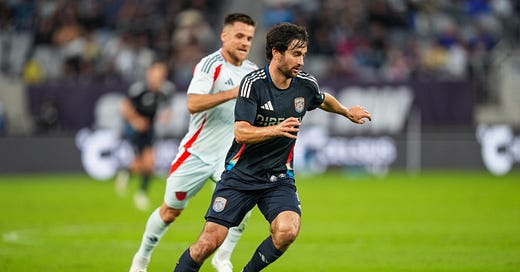Can we all just admit that MLS is terrible?
Why US’s top flight is bad, why it matters, and what to do about it
At Snapdragon Stadium, in a drafty concrete corridor, Don Garber held a media availability before San Diego FC’s first-ever home game. Garber is not a star athlete. He is not a star. He is the longtime commissioner of Major League Soccer. It’s not everyday, though, that the head of a major American sports league affords the press unfettered and unstructured access in a place that looks like a freeway underpass.
We in the press pool dutifully held up our phones and recorders and cameras, capturing for posterity platitudes and clichés and lapel pins, while a handler listened intently to the questions and tried to beam the right answers into the back of his boss’s head. It worked. Garber said nothing interesting. In five minutes the event was over, and the two men glad-handed their way back to a catered suite. The imperiousness annoyed me.
But Garber did have reason to smirk and nod emphatically through lines like, “We are a league for a new America.” San Diego FC is the league’s 30th team, and its ownership group paid $500 million to MLS for that privilege. When Garber took the reins at MLS in 1999, there were just twelve mostly bankrupt teams. Twenty-three years later, Apple paid MLS $2.5 billion to broadcast its games, and the league is now the second-highest attended in world football. By almost any metric, MLS is more popular than ever and is growing like gangbusters.
This is remarkable because, for six distinct but related reasons, MLS is very bad.
League structure - MLS cannot tolerate competition
If this newsletter is about anything, then it’s about sports league structures, a riveting topic that has resulted in millions of subscribers. As for MLS, it follows the model common in the US. It’s a closed league with a fixed membership (except in the cases of expansion and contraction).
To most American sports fans, this is trivia, an occucous fact taken at face value, as if on the sixth day God created the NFL and the like, but the American sports league industry, including MLS, is intentionally built on operating cartel monopolies. Monopolies are generally illegal in the US—thank you, Mr. Sherman, whoever you were—but as long as a CEO doesn’t write in an email “I AM COLLUDING TO SUPPRESS COMPETITION AND INCREASE PRICES,” then they’re more or less tolerated. MLB even has an exemption to antitrust law.
To be clear, having multiple major leagues and having promotion and relegation are different concepts. In the early days of professional baseball, several major leagues competed for fans, but none employed promotion and relegation. In world football, there’s typically only one league in a country’s first division, but that division sits at the top of a “triangle” which is based on promotion and relegation.
The broader point is that the modern closed league structure in the US makes either form of competition impossible. In fact, such competition would be ruinous to the extant leagues, as NBA commissioner Adam Silver admitted in 2022. The leagues’ teams pooling resources and coordinating action is what suppresses competition and limits the supply of professional sports. This mitigates risk to incumbent team owners’ investments, which comes at the expense of fans, as we’ll see as this list progresses.
MLS takes the model even further, though, because its team owners aren’t really team owners. The league itself owns all the teams and player contracts, and “investor-operators” buy into that common entity and merely represent and operate one of the franchises.
So imagine a king divides his realm into 30 plots of land and rewards each plot to a nobleman. The king then makes the noblemen compete to turn their land into the most productive in the realm until, through the labor of peasants, one nobleman is crowned the most productive. The king gives this nobleman a jewel for his troubles, but then usurps the harvest and distributes it to the other noblemen. With nothing actually on the line, what was the point of the competition? Welcome to Major League Soccer, which is a 90-page script away from being the WWE.
One of my great frustrations with American sports is that financial success isn’t tied to winning, and that there are no consequences for losing, and the strained metaphor above encapsulates that.
Finally, MLS not being embedded in a promotion/relegation system puts it on par with professional leagues in Gibraltar, Papua New Guinea, and Sri Lanka. Even Real Madrid, the most successful club team in the world, is subject to relegation in Spain’s La Liga, but God forbid St. Louis City SC faces any consequences for being irrelevant. This sends a powerful, if subliminal message: MLS is an unserious league, one in which the powers that be make sure no owner gets their feelings hurt. Of course, nearly all the owners are white, rich, and male. And they call liberals snowflakes.
Roster rules - MLS hates good players
I do not understand GAM and DPs, and casual fans should not need to, but the gist of MLS’s nonsensical roster rules and machinations is that they act in service to a salary cap, which in 2025 is $5,950,000. (England’s Southampton, which is getting relegated to the second division and might finish this year as the worst Premier League team ever, has a wage bill ten times that.)
Put simply, MLS’s salary cap prevents its teams from signing good players. This is by design, as the YouTube channel Zealand reported.
The North American Soccer League, MLS’s most notable predecessor, gained popularity in the 1970s by signing famous has-beens. A 34-year-old Pelé joining the New York Cosmos is the most famous example, and teams competed for other aging stars. Teams eventually spent themselves into oblivion, with only a couple owners actually able to afford the going rate of a competitive team, and the league folded in 1985. From the ashes rose MLS, which protected against owners’ recklessness and independence by adopting its unique league structure and imposing a salary cap.
These tools allow the MLS to maintain a player draft, an expansion draft, and an “allocation process.” They’re what allows the league to strictly control its labor and in turn its costs.
Mediocrity, then, was and remains the entire point of MLS, and the arbitrary rules invented to allow Messi and Beckham to play in MLS are exceptions that prove the rule. Average players are cheap players, just the way the league wants it. Average players are also less entertaining players, but MLS teams aren’t discounting their ticket prices for that. They don’t need to. They’re literally the only game in town.
Parity - MLS hates good teams
A friend and I have a running bit after each San Diego FC game, when one of us texts the other, “Is SDFC good?” Beat the Seattle Sounders 3-0? That sounds great! Lose 3-0 to Charlotte? Who knows what that means! It’s next to impossible for a casual fan to discern who’s good or not in MLS, which leads to a disorienting experience.
Like any league with a salary cap, MLS spins its labor cost controls as a way to promote this sort of parity and competitive balance, but journalist Sam Stejskal pushed back in a revelatory article for The Athletic. “The league feels very homogenous,” Stejskal wrote in 2022. “The margins between teams seem almost too thin. The bulk of MLS is of such similar quality that it’s difficult to assign meaning to results. The volatility between years throws the value of historic seasons into question. Everything feels too random.”
Stejskal enlists the sports economist Stefan Szymanski to support this argument. “Competitive balance was a technical notion dreamt up by the leagues… to defend themselves from antitrust suits, then it was really taken on by economists as some kind of technical measure which could be precisely defined,” Szymanski said. “But what really drives people are things like suspense and uncertainty and surprise and all these kinds of concepts which are somewhat vague and more difficult to quantify.”
In other words, people are drawn to sports by story, and in this regard the MLS is the first and only line by a student who doesn’t care about the writing assignment: “There was a man.”
As Stejskal put it, “There are no Lakers or Celtics; no Cowboys or Patriots; no Dodgers or Yankees or Red Sox; no Manchester City or Liverpool or Manchester United or Chelsea… MLS needs strong, national teams. Heroes and villains. Teams that can be held up as both objects of derision and as measuring sticks.”
Studies haven’t found a correlation between parity and fan interest, so MLS is selling a feature of its product that no one cares about. That feature may even be limiting interest. The salary cap, the resulting parity, and the postseason tournament, for which more than half the league qualifies, perversely incentivizes teams to not go for it. There’s little point in signing better (and more expensive) players if, by just existing, teams have a pretty good chance at the title. Stejskal pointed to the Sounders and Portland Timbers as perennial contenders that often drift through the regular season this way.
MLS is in effect selling a competition among mostly forgettable players and teams in which competition is besides the point. The soccer-mad fans in the US, desperate for a meaningful top flight, have no choice but to pay for that bogus product. Szymanski put it well: “That’s what I would say happens in the American system.”
Location - MLS limits supply of soccer
Because there is no promotion or relegation, MLS unilaterally decides where its mediocrity happens. San Diego had long been a hotbed of soccer fandom, but it went without a top flight men’s team for decades because it didn’t have a soccer-specific stadium. It didn’t seem like it would build one, either, until San Diego State opened Snapdragon Stadium in 2022 after a long political saga. This served as the basis for San Diego FC’s successful $500 million bid to enter MLS.
This example reflects why MLS’s geography is so advantageous to their bottom line. First—say it with me this time—it suppresses competition. There is no economic or demographic basis for cities having only one major league team per sport, except for New York, Chicago, and Los Angeles. These may have no more than two teams, apparently.
Conversely, the aforementioned Southampton, England, is an ancient port town of just 250,000. Manchester is a post-industrial city of 560,000 and it supports two of the biggest sports teams in the world. London has seven teams in the Premier League this season. New York City, with a comparable population, has five teams across MLB and the NBA and NHL. (The New Jersey Giants and Jets don’t count.) The “one city, one team” pattern in the US is solely a product of monopoly.
It also doesn’t at all reflect fan interest or local culture. With their founding, San Diego FC effectively killed off the San Diego Loyal, the once-popular and now-legendary team in the second division United Soccer League. The Loyals’ supporter group graciously joined SDFC’s coalition of supporter groups, but surely it costs far more to be an MLS fan, to speak nothing of what was lost in the cultural fabric. How cool it would have been to have multiple professional teams in different divisions playing in the same city.
Secondly, leagues can extract subsidies from public authorities and higher bids from prospective owners by limiting the supply of its product. The examples of this are too numerous and too depressing to highlight. At least with San Diego FC there wasn’t a direct public subsidy. SDSU built Snapdragon Stadium primarily for its football program, and SDFC is a tenant, so it’s worth celebrating when a billionaire doesn’t flip us upside down and shake us down for our lunch money.
Schedule - MLS plays soccer in Texas in August
Remember those times at recess when a friend would take a self-righteous stand but everyone ignores them and continues playing and having fun? And then that friend would obviously be jealous and embarrassed but they dig their heels in so as to avoid eating crow? That friend is MLS, which plays from February to October, while the rest of the world plays from August to May. At this point, it’s embarrassing that MLS remains committed to being a novelty.
Product quality - MLS gameplay is pitiful
Out in Left is a labor-friendly newsletter, so I say to the players with all the empathy and tenderness of Robin Williams: It’s not your fault.
It’s not your fault you play in a closed league that disincentives signing good players and fielding good teams. It’s not your fault that your employer doesn’t care about competition. It’s not your fault that MLS prefers to limit soccer than offer it.
But the gameplay is awful. It’s hard to describe, since the actions of soccer are universal, but, like greatness, you know crap when you see it. The players simply do not have the speed and technical ability to create a product worth paying Apple $100 to watch on TV. Formations collapse at the slightest bit of pressure. Passing is poor. Defenders can’t close down on attackers effectively. Finishing isn’t precise. Many games devolve into “chase the ball,” with offenses launching a barrage of long, over-the-top passes to exploit the space that their opponents are too small, slow, or bad at filling.
This is not to diminish fans’ excitement for their teams. Many great fan cultures and traditions dot the MLS landscape. LAFC’s “3252” coalition of supporters is at the top of the list. But supporters are giving the league far more than what it is giving them.
So what do we do about it?
First, Congress needs to pass a law—
I’m just kidding. I’m not that naive.
In his piece for The Athletic, Sam Stejskal outlines how loosening MLS’s roster rules can result in a more dynamic league. Specifically, the league should shift from its stringent salary cap to a spending floor and ceiling. This would allow teams to spend more and develop the storylines that are missing in MLS. It’s a modest proposal, especially given that the playoff format will retain the league’s trademark parity, and it’s one the players’ union could incorporate into their bargaining strategy and feasibly achieve.
Stejskal also suggests reducing the size of the playoffs so as to make regular season games matter more. I agree, but here he is naive. More playoff games equals more TV rights and ticket sales, which equals more money to the league, which equals more money distributed to the players. “Playoff creep” is everywhere—MLB and the NFL and NBA all expanded their playoffs in recent years. That toothpaste isn’t going back into the tube.
In March, USL approved promotion and relegation, and it plans on launching a first division in the 2027-28 season. It’s another way to pressure MLS, even if the USL press release didn’t mention its big brother. “With this historic step, the USL aligns with the world’s top leagues—including the Premier League, La Liga and Bundesliga—where promotion and relegation raises the stakes of every match, drives fan engagement, and elevates the overall competition of the game.”
USL clearly views MLS monopoly as vulnerable, and the upstart league could result in MLS opening up its own league structure (unlikely) or MLS buying out or co-opting USL’s pyramid (more likely). Jordan Wise, in the Gameplayer newsletter, even argues that USL will eclipse MLS. In any case, competition will force MLS to rethink and possibly reform its model and game product.
Fans can have a roll, as well, as popular revolts have resulted in everything from Manchester City backing down from raising ticket prices next year to the collapse of the proposed European Super League. Fan bases stateside probably have less power due to the league monopolies—as Cincinnati Reds owner Phil Castellini once put it, where else are fans going to go?—but it is different in soccer. Supporter groups are well-organized, stand apart from the casual fan base, and often work closely with teams. I can see one day a team’s supporter section walking out of a game or otherwise protesting effectively to oppose a lack of investment (or other transgression).
And why is this important?
Soccer is exploding in popularity in the US. MLS’s growth is one indication of that, and so is the presence of the Club World Cup this summer and the real World Cup in 2026 and the Olympics in 2028 and international club teams falling over themselves to play exhibitions here. Fueling all of this is normal human beings—consumers, in the parlance of league executives—who fork over their discretionary income to divert their attention for a couple hours from the tedium and concerns of workaday life.
That “deal” would be fine if American consumers were getting commensurate value. They are not. Season tickets next year for Everton, a Premier League team that hasn’t been relegated in 74 years and is moving into a brand-new stadium, start at $45 a game. Season tickets to San Diego FC, an expansion team that plays in a league in which mediocrity is the raison d’etre, start at $40 a game. There is even a choice for Liverpudlians. They can cheer for Liverpool or for Everton. San Diegans have no choice. MLS wouldn’t let us have that.












MLS is in a unique business position for an American league because, unlike NFL/NBA/MLB/NHL, the best players in the world do not play here. It's never going to be the case that 90+% of the best play here. So MLS should be asking itself how, as a business, it can compete for soccer attention here. It has a monopoly on professional soccer TEAMS in the US, but it has no monopoly on sports entertainment and no monopoly on soccer as TV entertainment. Americans can watch the NFL or they can watch EPL, Liga MX, etc.
MLS can't run the NFL playbook and it can't run the LALIGA playbook or EPL playbook. I understand the concept that relegation and open leagues generates competition, but it's an insane business practice and should NOT be adopted by MLS. There is probably a reasonable floor of interest here that means MLS can suck but the league and owners still make a profit. But if they want to grow huge they need a plan to beat their competition and they need to understand who that competition is. I would argue that MBL and NBA are the targets. To win they need to do something truly different, not just be the soccer version of the same thing.
So what should they do? Or rather, where should they find inspiration? Indian Premier League Cricket, obviously.
Mostly agree. There are good stories to be had (Nancy’s Columbus, this year’s Whitecaps) but most of the league feels like a vague soup except for the team I follow. It’s unclear what the way forward for MLS is, and sometimes I wonder if there is even a market for an American soccer league that competes with Europe. The Premier League might just be too entrenched in the US.